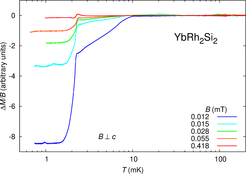Press Release: Heavy fermions form Cooper pairs with the aid of nuclear spins
Interplay between bad-metal behavior, electronic magnetism, nuclear spins and unconventional superconductivity
Physicists from the Walther Meissner Institute of the Bavarian Academy of Sciences (Garching), the Max Planck Institute for Chemical Physics of Solids (Dresden), Rice University (Houston, USA) and Renmin University (Beijing, China) have discovered unconventional superconductivity at ultra-low temperatures in a canonical heavy-fermion metal made from ytterbium, rhodium and silicon.
This material, YbRh2Si2 (YRS), has been intensively studied by the Dresden group over the last fifteen years. It has become a model system to study the destruction of heavy fermions, composite charge carriers whose effective mass exceeds the mass of the free electron by a factor of 1000, on the brink of weak antiferromagnetic order. This breakdown of the Kondo effect bears resemblance to the so-called Mott transition at which the electrons, due to their strong mutual correlations, can be either localized in an antiferromagnetic insulator or itinerant in a bad metal. Such Mott transitions exist, e.g., in the oxycuprate superconductors with high transition temperatures and in several superconducting organic charge-transfer salts. In contrast to the afore-mentioned material classes, rare-earth-based heavy-fermion metals have well-separated energy scales for the relevant electronic, magnetic and elastic excitations, which allows physicists to study quantum fluctuations and superconductivity near a Kondo destroying instability in great detail. This promises a deeper insight into the origin of high-temperature superconductivity in the cuprates, one of the most eminent unsolved problems in condensed-matter physics. However, the fact that up to now no superconductivity was seen in YRS down to temperatures of the order of 10 milliKelvin, made the interrelationship between Mott-type instability and superconductivity questionable. For their measurements, the authors used a nuclear demagnetization cryostat, a highly devoted apparatus at the Walther Meissner Institute, that exists only at a few other places worldwide and provides a base temperature way below 1 milliKelvin. They were able to detect superconductivity in YRS which sets in at a transition temperature Tc = 2 milliKelvin, see Science 351, 485-488, 29 January 2016.
When looking at the results of their specific-heat measurements, the authors surprisingly recognized that the effective charge-carrier mass was seemingly increasing by another factor of 1000, when the material became cooled to below Tc. This clearly demonstrates that some nuclear interactions must be operating in this ultra-low temperature regime. In analyzing the experimental data the theorists from Rice and Renmin found that the arrangement of the spins of the ytterbium nuclei helped to create superconductivity. According to this analysis, the nuclear spins become coupled at extremely low temperatures and arranged in an ordered pattern that competes with the primary antiferromagnetic order and exposes the electronic quantum critical fluctuations on the brink of magnetic order. It is most likely that the latter are the driving force for Cooper pairing in this unconventional superconductor; in other words, they appear to be the analogue of the lattice vibrations in a conventional (BCS) superconductor.
The new publication demonstrates that the emergence of unconventional superconductivity near antiferromagnetic instabilities (as previously observed in the absence, and now in the presence, of a Mott-type electronic instability) is a general phenomenon, which exists not only in the cuprates, organics and, presumably, the new iron-based superconductors, but also in heavy-fermion metals which are considered model systems for extremely strong electronic correlations in quantum matter.
The research was supported by the German Research Foundation, the Robert A. Welch Foundation and the National Science Foundation.
FS / CPfS

Superconductivity in YbRh2Si2
The sharp diamagnetic drop in the magnetization at Tc ~ 1 mK indicates the superconducting phase transition. The transition can be suppressed by a magnetic field.
